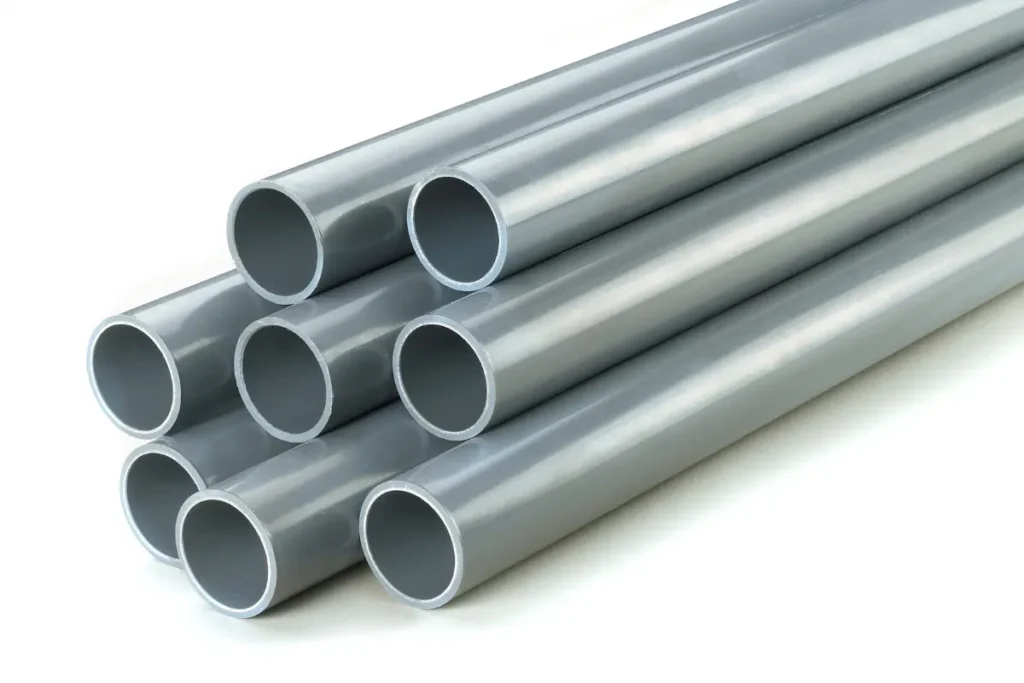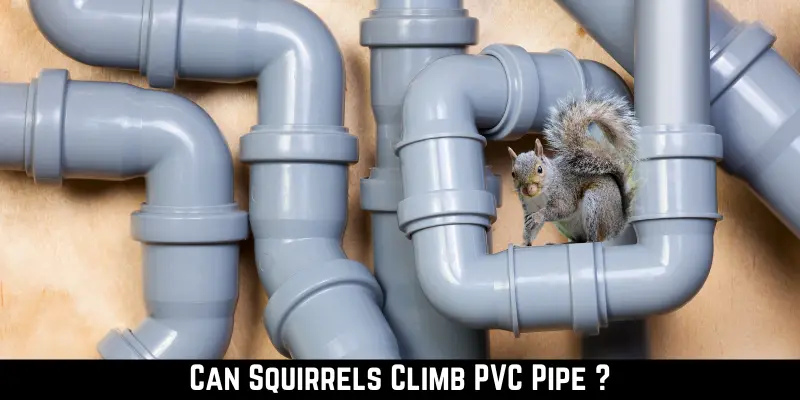The white plastic pipe, known as PVC, is utilized for drainage and plumbing. In construction, PVC has replaced metal piping. I am curious to know, Can Squirrels Climb PVC Pipe?
Squirrels cannot climb PVC pipes with a diameter of more than 2 inches. They require friction force to cling to a pole to climb. The less rough and friction-producing a material, the harder it is to climb.
PVC pipes are less rough than metallic. Increasing the pipe’s diameter makes it almost impossible for squirrels to climb. To know more about which PVC pipe can squirrel climb, keep reading the article.
Can Squirrels Climb 2-Inch PVC Pipe?

Yes, they can climb a 2 –inch PVC pipe as it has a minimal diameter. PVC pipes, whose diameter is measured in inches and used in construction, can be a quick and easy way to scale squirrels.
PVC pipe that is at least 2 inches wide as a general rule. The climbing will be more effective the less resistance there is. Like PVC, a polyethylene pipe is a form of plastic.
However, it is more aesthetically pleasing because it is black and has a lower roughness factor of 0.0002.
If you’re wondering what a k: mm is, think about the roughness of a firm concrete surface, which ranges from 2 to 9. The natural roughness of PVC pipes is 0.02.
When touched, PVC pipes feel softer than metal ones. If the squirrels try to climb the pipe, it would be pretty tricky to do so with a wide diameter.
Can Squirrels Climb 4-Inch PVC Pipe?

No, squirrels cannot climb a 4-inch PVC pipe. Due to their robust construction and smooth surface, PVC pipes are typically impossible for squirrels to rise, mainly dependent on the double articulation of their hind legs.
The squirrel achieves this by clinging to the surface; therefore, the smoother the pipe, the less effective it is because it is harder to climb.
Squirrels have been observed to climb more than ten feet horizontally. It’s crucial to remember that squirrels can use a variety of objects as launchpads for their jumps, in addition to trees. Along with other things, they can use houses, power lines, and decks.
Squirrels can wrap their paws around any smooth wood or small diameter slippery pole to climb it. Still, the combination of a large diameter and smoothness inhibits them by preventing any hold.
Can Squirrels Climb 8-Inch PVC Pipe?

No, squirrels cannot climb an 8-inch wide PVC pipe. An 8-inch PVC pipe 6 feet long and one treated 4x4x8-inch post are obstacles that squirrels typically cannot climb. If PVC pipe is large enough in diameter, they cannot climb on it.
Since PVC pipes are categorized as plastics used in construction and have a variety of diameters measured in inches, they can effectively address the issue of climbing squirrels.
Because plastic pipes are lighter than metal ones, they can be used in wider diameters to reduce friction and deter squirrels from climbing.
We may use the squirrel’s climbing skills to evaluate the pipes’ functionality. Six-inch or even eight-inch PVC is popular. A squirrel has less probability of finding a way up a tube with a bigger diameter. Slide the box over the treated fence post after installing it 2 feet into the ground.
Why Can Squirrels Not Grip On PVC Pipe?
PVC pipe provides a slippery surface that stops squirrels from climbing up your pole because they can’t grip it, making it impossible for them to do so. The less rough and friction-producing a material, such as PVC pipes, the more difficult it is for a squirrel to climb.
However, a squirrel needs friction force to cling to a pole to climb it. You may also stop squirrels from climbing your bird feeder pole by replacing your wooden stick with a PVC post. This will prevent squirrels from climbing up to the feeder.
PVC pipe feeder poles are far more difficult for squirrels to climb than other types. This is because of how slippery and difficult it is to dig claws into the hard plastic of PVC. PVC is cheap and works excellently as a squirrel-proof bird feeder pole.
Do Squirrels Use Their Tails When Climbing PVC Pipe?
Squirrels use their bushy tails for communication and support while performing their dangerous climbing, jumping, and balancing maneuvers. Take a closer look at one moving along a PVC pipe. It will be moving its tail constantly stays balanced.
When they climb PVC pipes, their tails serve as a rudder, guiding them through the open area so they can land safely on the tree directly across them. A squirrel’s tail comes in useful if it hits a wall its aim or takes a tumble from a PVC pipe.
It also aids in minimizing the impact of the hit. The squirrel will spread its weight as it gets closer to the ground by using its tail, which will lessen the force on its body. This allows squirrels to endure falls of up to 30 meters without suffering any harm.
Are There Any Benefits To Squirrel Climbing PVC Pipe?
Yes, Squirrels with enough willpower can chew through PVC pipes because their front teeth can grow so long that they are useless for eating, which would cause them to starve to death.
That’s why squirrels gnaw through a layer of pipe. The squirrel will eat anything it can get its hands on and break into your attic to begin nesting.
The rodent family includes squirrels, which are among the most prosperous mammals. Rodent means “to gnaw.” They are skilled chewers, as are all rodents. If they do not gnaw, their teeth will grow to such lengths they become unmanageable.
The same foods that birds enjoy eating are also enjoyed by squirrels, who would do virtually everything to obtain the meal. They can climb anything, walk on the wire, jump four feet square, and ten feet laterally.
How To Stop Squirrels From Climbing PVC Pipe?
You can use several ways to stop squirrels from climbing PVC pipes. The idea of creating a physical barrier is the foundation of most of them. For health and safety concerns, it is best to avoid other techniques like grease or oil.
1- By Cone Shaped Squirrel Baffle

Like an upside-down funnel, as the name implies. This baffle style efficiently prevents squirrels from climbing the PVC pipe, even if they climb up or jump to it from the ground.
The cone-shaped baffle is designed to tip over if a squirrel falls on it, allowing it to slip downward. Additionally, it’s crucial to check that the base is sufficiently wide to enclose the pipe’s bottom completely.
2- By Using Slinky

Using a slinky is one method for deterring squirrels from climbing PVC pipes. Due to its low cost and simplicity, this is a trendy solution. A slinky is available in any nearby store.
After that, put that inside the PVC pole, fasten it at the top, and then let it fall. A squirrel using a slinky to climb the pipe will just be knocked back down to the ground. The squirrel will fail no matter how many times it attempts to climb up.
3- By Irish Soap

The smell of Irish Soap repels squirrels and other vermin. Squirrels can be kept at bay with the use of Irish spring soap. The squirrels will detect the powerful Irish Spring perfume thanks to their great sense of smell.
A nearby sock with Irish Soap in it can be hung to deter them from climbing PVC pipe. This approach works well and is humane because it has no negative effects on the squirrels. Simply, it prevents them from climbing.
4- Copper Poles

Squirrels find it more difficult to climb copper poles than other types of metal or wooden pipes. PVC pipes are less aesthetically pleasing than copper or metal, but they are also tougher for squirrels to climb.
This approach is humane because it doesn’t harm the squirrels or use harmful chemicals; instead, it makes them slide down the feeder pole.
Conclusion
Some materials, like PVC pipe, are great squirrel deterrents since squirrels can’t grab them. PVC pipes are not climbable by them due to their rough surface.
The more friction-producing a material is, the harder it is for squirrels to climb since they need friction force to climb. They can scale most surfaces because they are natural climbers.
They are only permitted to jump a maximum of five feet from the ground, seven feet from a tree, or nine feet from the side of a structure. Always keep in mind that squirrels aren’t able to climb more than the 2-inch diameter from the ground.
References
Youlatos, D., He, G., Guo, S. et al. Positional behavior, habitat use, and forelimb morphology of Père David’s Rock Squirrels Sciurotamias davidianus (Milne-Edwards, 1867) (Sciuridae, Rodentia) in the Qinling Mountains, Shaanxi, China. Mamm Biol 101, 567–580 (2021)
Bertrand, O.C., Püschel, H.P., Schwab, J.A. et al. The impact of locomotion on the brain evolution of squirrels and close relatives. Commun Biol 4, 460 (2021)

